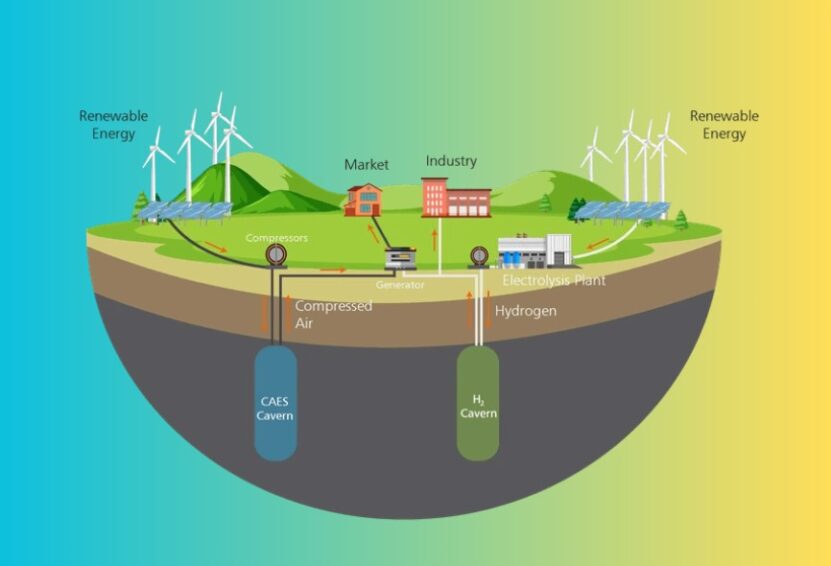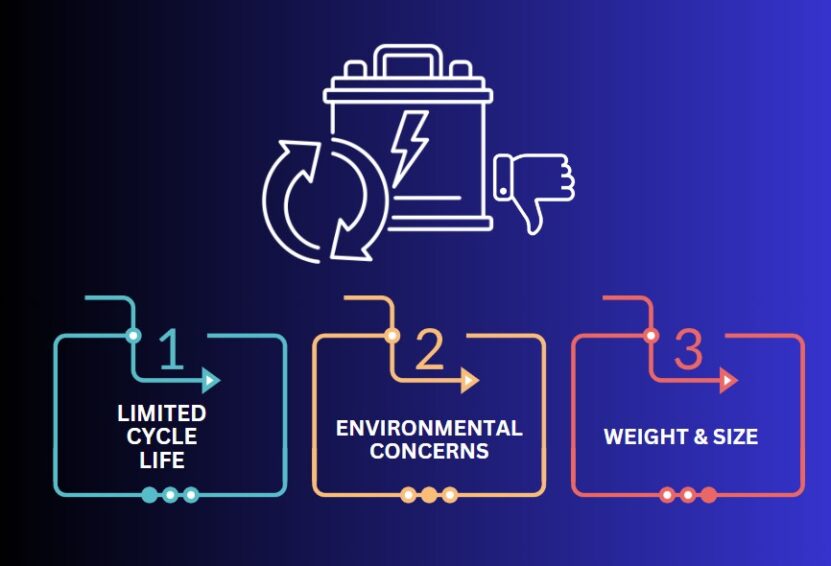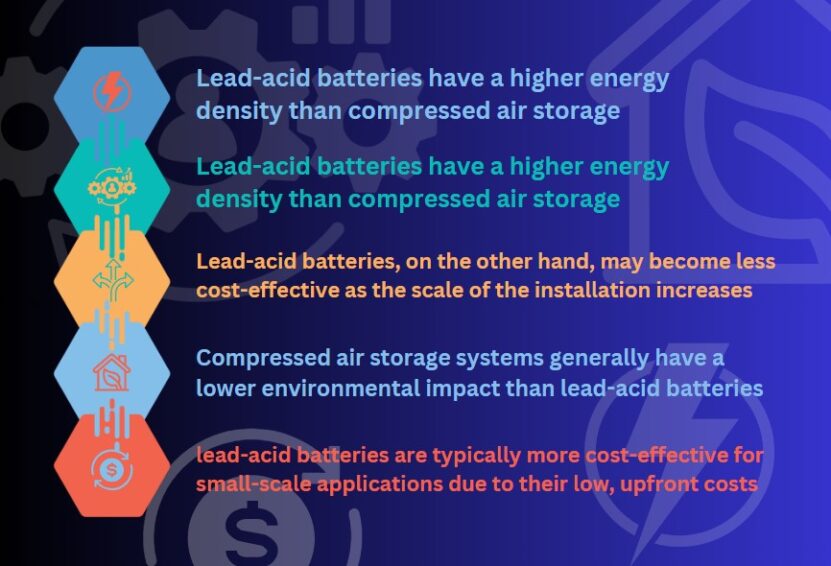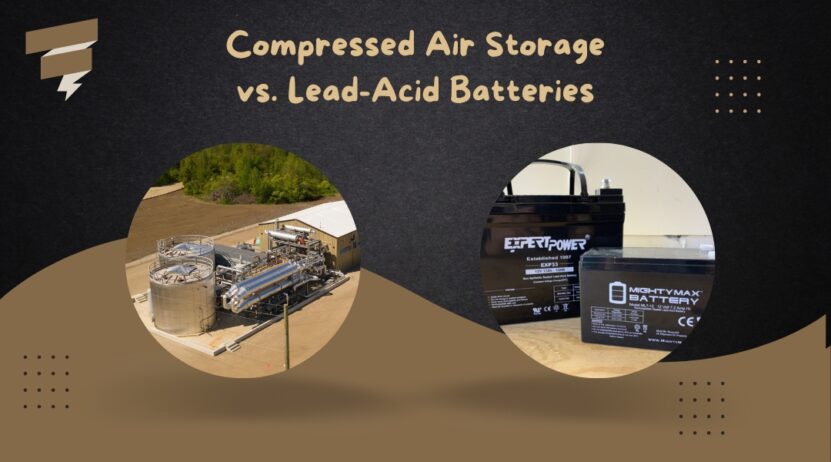Energy storage is a critical aspect of modern society, as it allows us to harness and store energy for use when it is most needed. With the growing demand for renewable energy sources, finding efficient and reliable methods of storing energy has become increasingly important.
Two popular options for energy storage are compressed air storage and lead-acid batteries. In this comprehensive and engaging article, we will explore the features, advantages, and disadvantages of these two energy storage solutions to help you make an informed decision on which option is best for your needs.
Overview of Compressed Air Storage
Compressed air storage, also known as compressed air energy storage (CAES), is a method that involves compressing air and storing it under high pressure in underground caverns or above-ground storage tanks. When there is a demand for energy, the compressed air is released, which drives a turbine connected to a generator, producing electricity.
Types
There are two main types of compressed air storage systems: diabatic and adiabatic.
1. Diabatic CAES
Diabatic CAES systems store compressed air in underground caverns, where the compression process generates heat. The heat is released into the surrounding environment while the compressed air is stored. When the air is released to generate electricity, natural gas or another external heat source is used to reheat the air, increasing its pressure and efficiency. Diabatic CAES systems are the most common type in use today.
2. Adiabatic CAES
Adiabatic CAES systems store the heat generated during compression in a separate thermal storage system. When the air is released to generate electricity, the stored heat is used to reheat the air, eliminating the need for natural gas or another external heat source. Adiabatic CAES systems are still in the research and development stage, with a few pilot projects underway.
Advantages of Compressed Air Storage

1. Scalability
Compressed air storage can be scaled up or down depending on the storage capacity and power generation requirements. This scalability makes it suitable for various applications, from small-scale installations to large grid-connected systems.
2. Long Life and Low Maintenance
Compressed air storage systems have a long lifespan, often exceeding 30 years, with minimal maintenance requirements. This longevity makes them an attractive option for long-term energy storage solutions.
3. Environmental Impact
Compressed air storage systems have a lower environmental impact than many other energy storage solutions. They do not rely on harmful chemicals or produce hazardous waste, and they use natural, abundant resources like air and underground caverns.
Disadvantages of Compressed Air Storage
1. Geographic Limitations
One of the main drawbacks of compressed air storage is geographic limitations. Suitable underground caverns or above-ground storage tanks are not available in all locations, making this technology less accessible for certain regions.
2. Energy Efficiency
Diabatic CAES systems are less energy-efficient compared to other energy storage solutions due to the heat loss during the compression process and the use of natural gas to reheat the air during expansion.
Overview of Lead-Acid Batteries
Lead-acid batteries are rechargeable electrochemical energy storage devices that store energy through a chemical reaction between lead plates and an electrolyte solution of sulfuric acid. They are widely used in various applications, from automobiles to backup power systems.
Types
There are two main types of lead-acid batteries: flooded (or wet) and valve-regulated lead-acid (VRLA) batteries.
1. Flooded Lead-Acid Batteries
Flooded lead-acid batteries, also known as wet or liquid electrolyte batteries, contain a liquid electrolyte solution that submerges the lead plates. These batteries require regular maintenance, such as topping off the electrolyte level and cleaning the terminals to prevent corrosion.
2. Valve-Regulated Lead-Acid (VRLA) Batteries
VRLA batteries are sealed and maintenance-free, containing a gel or absorbed glass mat (AGM) electrolyte instead of a liquid solution. The sealed design prevents leaks and reduces the risk of corrosion, making them more user-friendly than flooded batteries.
Advantages of Lead-Acid Batteries
1. Proven Technology
Lead-acid batteries have been in use for over 150 years and are a proven reliable technology. They are well-understood and widely available, with established manufacturing processes and a global supply chain.
2. Cost-Effective
Compared to other energy storage solutions, lead-acid batteries are relatively inexpensive. Their low initial cost makes them an attractive option for budget-conscious consumers and businesses.
3. Recyclability
Lead-acid batteries are highly recyclable, with over 90% of their components being reusable. This reduces their environmental impact and contributes to a circular economy.
Disadvantages of Lead-Acid Batteries

1. Limited Cycle Life
Lead-acid batteries have a limited cycle life, meaning they can only be charged and discharged a certain number of times before their performance degrades. This limitation can result in higher long-term costs due to the need for replacement batteries.
2. Environmental Concerns
The production and disposal of lead-acid batteries can be harmful to the environment due to the use of toxic materials like lead and sulfuric acid. Proper handling, recycling, and disposal are essential to mitigate these risks.
3. Weight and Size
Lead-acid batteries are bulky and heavy compared to other energy storage solutions. This can limit their application in space-constrained environments or portable applications.
Comparing Compressed Air Storage and Lead-Acid Batteries

1. Energy Density
Lead-acid batteries have a higher energy density than compressed air storage, meaning they can store more energy in a smaller space. This can be advantageous for applications with limited space or where portability is essential.
2. Efficiency
In terms of energy efficiency, compressed air storage systems (especially diabatic CAES) tend to be less efficient than lead-acid batteries. The energy losses associated with compression and expansion processes can reduce the overall efficiency of compressed air storage systems.
3. Flexibility and Scalability
While both energy storage solutions offer flexibility and scalability, compressed air storage has an advantage in large-scale applications due to its ability to be scaled up without significant increases in cost or complexity. Lead-acid batteries, on the other hand, may become less cost-effective as the scale of the installation increases.
4. Environmental Impact
Compressed air storage systems generally have a lower environmental impact than lead-acid batteries, as they do not rely on toxic materials and have a longer lifespan. However, the availability of suitable storage locations for compressed air can be a limiting factor in some regions.
5. Cost
When comparing costs, lead-acid batteries are typically more cost-effective for small-scale applications due to their low, upfront costs. However, the long-term costs associated with battery replacement and maintenance can make compressed air storage more attractive for larger installations.
Closing Thoughts
Both compressed air storage and lead-acid batteries offer unique advantages and disadvantages as energy storage solutions. The best choice for your needs will depend on various factors, including the scale of the application, available space, budget, and environmental considerations.
Ultimately, it is essential to thoroughly research and evaluate the specific requirements of your energy storage project to determine the most suitable solution. As the demand for renewable energy and efficient energy storage solutions continues to grow, further advancements in compressed air storage and lead-acid battery technologies will likely emerge, providing even more options for consumers and businesses alike.

